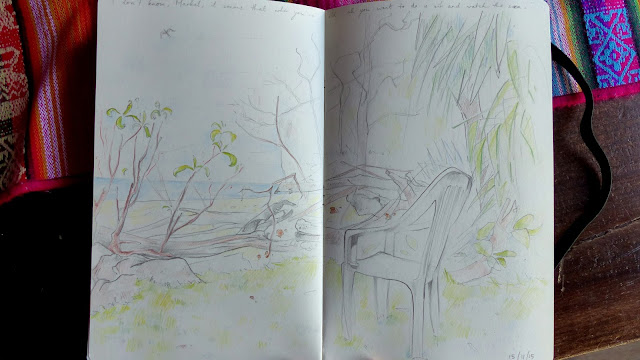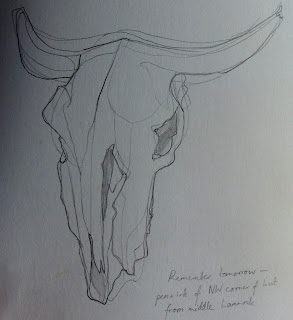Since I have already added all my decent photos on Facebook, this post is composed mostly by sketches. There's also a whimsical little story. Enjoy!
 |
| A vine-clad tree in front of bougainvillea: the flora that dominate Playa Escondida. |
 |
| The spirit of Playa Escondida! Actually, this dog was at Quitumbe bus terminal in Quito, where we spent eight accidental hours on Saturday morning. |
Above - the decorations and flowers would be heaven for Georgia O'Keeffe!
 |
| I slept in every hammock. Swing and a miss, or a good joke? |
 |
| "When you're old, all you want to do is stare at the scenery. It's so strange. I've never felt so peaceful before." |
(NB. For anyone who finds the tale familiar, it was inspired by a short story called La Plage by Alain Robbe-Grillet. It's a beautifully evocative story, with a strong sense of mystery. Read it if you can get your hands on it!)
Two girls walk along a beach. One is red; the other, fair. They move forward, not together, and not apart, stopping here and there for a detail written in the sand, but always returning, walking on, to a point on the distant horizon.
They are walking halfway down a long strip of beach, aiming towards the west. To their left, towards the land, the sand shifts golden and floats buttery in the gentle breeze that blows in from the sea. A yellow cliff marks the boundary between the forest and the beach; the cliff is topped by white, faded trees, that resemble pieces of driftwood, cast off - yet they grow tall on the cliff's edge, and occasionally they drop an orange leaf, one or two, as proof or sign of life. This rhythmic signal is mirrored in the cliffs, for here and there, now or then, a few rocks slip from the layered sandstones and clatter down, showering on the golden sand below.
Apart from these two tones, the only sound of the land comes from the shallow calling of distant birds. The two girls do not reply. Instead the sea answers from the right, in rhythmic swells; blue and tranquil responses, interrupted occasionally by a raised voice or a gesture in the form of a larger wave, that is just as soon quelled by the darker, wet-pressed sand by the water's edge.
Where the girls walk is neither dark nor light but a middle-coloured bronze, that is formed of tiny shells and corals, white and orange and wind-washed and water-marked. The ground underfoot is just firm enough so that they can leave their trail, and if one were to look back towards the way they came, one would see two pairs of footprints, painted carefully and evenly into the canvas of the beach. One could even study these footprints, and then what would they see: but a distinction, quite clear, between the two that have walked there. The first set of prints are hardly visible: small and light, with barely a mark forming the inner crescent. The left foot has traced a slightly clearer line than the right. The second set of footprints are clearer still, and the whole shape of the foot is clearly outlined in the sand. It will remain there until a particularly energetic wave comes, and triumphs over the beach; but this act, eventually achieved, goes unnoticed by the two girls, one fair, the other red, who carry on their way, down the sand, towards the point on the distant horizon.
Once or twice they stop, pause, study their surroundings. Throughout their journey they have continued down the central line of the beach, and it is here where the pawn shop discarded by the sea grows thickest and most generous in the wares it displays. Bottled glass worn smooth to the tone of velvet; conical shells, once roughened, like old furniture unwanted by hermit crabs now grown; a curious piece of coral, pink and purple, with a quaint sea-flower, attached and still intact, like a jaunty and rakish feather on a bonnet. The red girl is walking further behind; she stops to pick up a pebble. It is half-buried in the sand, and the exposed face has been warmed by the sun. Released, its colours are set off in the light. A darkening green, like the forest; striped through with a streak or two of red, ochreous and pungent, the colour of rust or leaves in the fall. She places the stone back in the sand. The fair girl, ahead, turns back to her.
"Should we carry on to the next point, or should we go back?"
Two girls swim in the ocean to the west. One is red; the other, fair. The water moves around their bodies and laps at their hair; the sound of the shore is all around them, and with the wind and the tides and the waves, their inner ears close to the surface, it is as if they can hear the sea inside. The distance sharpens from blue to a green that darkens until, at the horizon, a pencil line of forest colour marks the limit of what they can see. At various times, the line is altered by a swelling wave that disappears mysteriously by the time it has reached the girls; and then the water is flat, all the way to the beach, where it crawls up the sand hungrily and gnaws on the grains and shells it finds there.
The red girl turns her face out to the horizon. The breeze blows in; she might be facing north. In the distance, the same swell forms and breaks the line of green. She turns to her companion, the fair girl; she is not looking out but inwards, towards the land.
"Do you think there's a sandbank out there?"



No comments:
Post a Comment